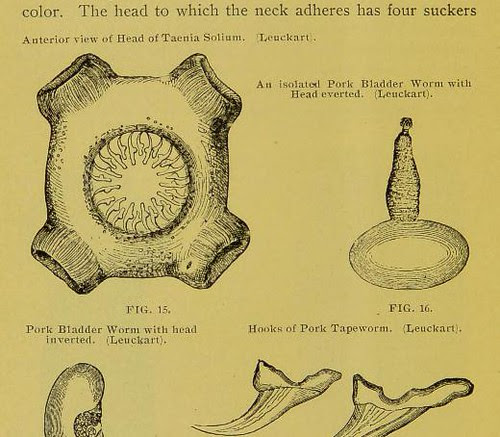
What is the function of a tapeworm's hooks and suckers?
Answer
468.3k+ views
Hint: Tapeworms are flat, segmented worms that dwell in some animals' intestines. When animals graze in meadows or drink contaminated water, they might become infected with these parasites. Tapeworm infection in humans is caused by eating raw or undercooked meat from infected animals.
Complete answer:
The structure of Rostellum is made up of a series of concentric rows of hooks. The upper row hooks, which are larger and have a projecting, rounded stout guard, and the lower row hooks, which are smaller and have a flattened guard, are the two primary varieties of hooks. The rostellum's primary function is attachment. It protrudes during attachment and enters the intestinal mucosa with hooks. This is especially necessary during meal digestion and bowel movement in order to prevent the tapeworm from being ejected with the faeces.
Hooks are tough, curving projections that protrude from a parasite's surface. They are frequently numerous and help with attachment by penetrating the host's tissues. Hooks (H) on tapeworm oncospheres enable them to breach the first intermediate host's intestinal wall.

Humans and animals both have tapeworms in their intestines. On one end, they have a number of hooks (or suckers) that they utilise to adhere to the gut and feed on the host.
Tapeworms attach to the gut wall with their anterior scolex, which may have hooks in addition to four suckers. Although they can cause some damage at the attachment site, they generally compete for nutrients with the host. They take nutrients through their surface since they lack an alimentary system.
Suckers and other structures on tapeworms and flukes allow them to feed on their hosts. Tapeworms have a scolex, which is a ring of hooks on their head that allows them to connect to the host. Instead, they use their suckers to collect nutrients straight from the host's digestive tract. Suckers and Hooks for Tapeworms
Note:-
The scolex (head) is an anchoring organ that adheres to the mucosa of the intestine. The neck is an unsegmented area with a high capacity for regeneration. If the neck and scolex are not removed during therapy, the entire worm may regrow. The rest of the worm is made up of several proglottids (segments).
Complete answer:
The structure of Rostellum is made up of a series of concentric rows of hooks. The upper row hooks, which are larger and have a projecting, rounded stout guard, and the lower row hooks, which are smaller and have a flattened guard, are the two primary varieties of hooks. The rostellum's primary function is attachment. It protrudes during attachment and enters the intestinal mucosa with hooks. This is especially necessary during meal digestion and bowel movement in order to prevent the tapeworm from being ejected with the faeces.
Hooks are tough, curving projections that protrude from a parasite's surface. They are frequently numerous and help with attachment by penetrating the host's tissues. Hooks (H) on tapeworm oncospheres enable them to breach the first intermediate host's intestinal wall.

Humans and animals both have tapeworms in their intestines. On one end, they have a number of hooks (or suckers) that they utilise to adhere to the gut and feed on the host.
Tapeworms attach to the gut wall with their anterior scolex, which may have hooks in addition to four suckers. Although they can cause some damage at the attachment site, they generally compete for nutrients with the host. They take nutrients through their surface since they lack an alimentary system.
Suckers and other structures on tapeworms and flukes allow them to feed on their hosts. Tapeworms have a scolex, which is a ring of hooks on their head that allows them to connect to the host. Instead, they use their suckers to collect nutrients straight from the host's digestive tract. Suckers and Hooks for Tapeworms
Note:-
The scolex (head) is an anchoring organ that adheres to the mucosa of the intestine. The neck is an unsegmented area with a high capacity for regeneration. If the neck and scolex are not removed during therapy, the entire worm may regrow. The rest of the worm is made up of several proglottids (segments).
Recently Updated Pages
Master Class 11 Economics: Engaging Questions & Answers for Success

Master Class 11 English: Engaging Questions & Answers for Success

Master Class 11 Social Science: Engaging Questions & Answers for Success

Master Class 11 Biology: Engaging Questions & Answers for Success

Class 11 Question and Answer - Your Ultimate Solutions Guide

Master Class 11 Business Studies: Engaging Questions & Answers for Success

Trending doubts
What is meant by exothermic and endothermic reactions class 11 chemistry CBSE

10 examples of friction in our daily life

One Metric ton is equal to kg A 10000 B 1000 C 100 class 11 physics CBSE

Difference Between Prokaryotic Cells and Eukaryotic Cells

What are Quantum numbers Explain the quantum number class 11 chemistry CBSE

1 Quintal is equal to a 110 kg b 10 kg c 100kg d 1000 class 11 physics CBSE




